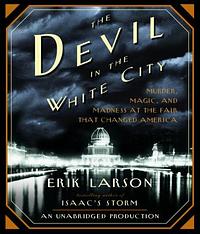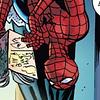Take a photo of a barcode or cover
9.36k reviews for:
The Devil in the White City: Murder, Magic, and Madness at the Fair That Changed America
Erik Larson
9.36k reviews for:
The Devil in the White City: Murder, Magic, and Madness at the Fair That Changed America
Erik Larson
I enjoy this type of narrative nonfiction that reads more like a novel. The combo of topics was perfect. I never would have picked up a book just on the world's fair or a psychopath from the 1890s, but putting them together really worked, even though it was mostly two parallel stories that hardly overlapped. Now I want to visit Chicago, even though I had a nightmare about having to move there while reading this book. Brrr.
slow-paced
Slow to start but very interesting ending! Hard to believe this isn’t fiction!! Could have been split into two books in my opinion.
dark
informative
mysterious
slow-paced
I’m often reluctant to post a review. My opinion is only mine. It likely won’t be yours. But I found this book mesmerizing. When I’m done reading any nonfiction and it leaves me wanting to research, visit sites, read references and more, it’s a great book. I don’t want to do any of that because of any doubts about the author. I want to do it because what I’ve learned makes me want to learn more. This is one of those books.
dark
informative
slow-paced
I found myself skipping the chapters on the construction of the fair entirely. I realize they padded the book, but I couldn't make myself slog through them anymore. However, the chapters about H. H. Holmes were captivating.
dark
tense
slow-paced
medium-paced
one of the more digestible non-fiction books i have read despite its abundance of facts. it's so cool to see how much impact the fair had afterwards. larson did a great job dropping a seed then presenting a full grown tree with the revelations made because i began to anticipate how the loose ends would come together. my only qualm was the lack of pictures (don't roll your eyes at me), but i didn't mind looking up the buildings he referenced. oh to have witnessed the world's colombian exposition (fuck columbus tho)
I couldn't get into this book. One day I'll finish it...
Having recently finished up [b:Death in the Haymarket: A Story of Chicago, the First Labor Movement and the Bombing That Divided Gilded Age America|171634|Death in the Haymarket A Story of Chicago, the First Labor Movement and the Bombing That Divided Gilded Age America|James R. Green|http://d.gr-assets.com/books/1320540888s/171634.jpg|618591], and previously having read [b:The Plan of Chicago: Daniel Burnham and the Remaking of the American City|110880|The Plan of Chicago Daniel Burnham and the Remaking of the American City|Carl Smith|http://d.gr-assets.com/books/1328872809s/110880.jpg|106816], I felt like I had a good grasp on both the Chicago of the late 19th century, and of the life of architect Daniel Burnham. Larson plots Burnham's arduous task of creating the World's Columbian Exposition, a massive world's fair in Chicago's Jackson Park. Sharing the space of Burnham's story is that of serial murderer H.H.Holmes, who used the fair's boost in tourism to attract victims to his specially constructed hotel. Interspersed within the two major narratives are asides and tidbits of an historical nature, often interjected with little regard for their narrative worth.
The book is much more Burnham than Holmes, no doubt because there is a wealth of material to use about the World's Fair, but not nearly as much chronicling Holmes' life. Larson does a great job of using quotes from Burnham's letters, and the letters and speeches of his contemporaries, to inject the real voices of the characters into the narrative. Unfortunately, it is not all the time that Larson cares for historical detail; he has no trouble penciling in speculation in the hopes of creating a compelling read. Such liberty with factual particulars often gets him nowhere, as the sections on Holmes, while of such graphic nature in content, read with all of the mystery and macabre of an episode of Scooby-Doo. Larson only hits his stride when recounting the investigation into Holmes' murders, and this is probably because he had more material to draw from.
The real problem is that the book is structurally malformed. What do H.H.Holmes and Daniel Burnham have to do with one another? Nothing. I guess Holmes did attend the fair at some time, but so what? Everyone did. The people just happened to live at the same time in the same city, and Larson could have chosen any two people to write about. The two stories don't even share any thematic or metaphorical overlap; they are nearly wholly separate. At least it is well researched, even if the research is ornamented with Larson's fictive embellishments. I would recommend a more traditional history.
The book is much more Burnham than Holmes, no doubt because there is a wealth of material to use about the World's Fair, but not nearly as much chronicling Holmes' life. Larson does a great job of using quotes from Burnham's letters, and the letters and speeches of his contemporaries, to inject the real voices of the characters into the narrative. Unfortunately, it is not all the time that Larson cares for historical detail; he has no trouble penciling in speculation in the hopes of creating a compelling read. Such liberty with factual particulars often gets him nowhere, as the sections on Holmes, while of such graphic nature in content, read with all of the mystery and macabre of an episode of Scooby-Doo. Larson only hits his stride when recounting the investigation into Holmes' murders, and this is probably because he had more material to draw from.
The real problem is that the book is structurally malformed. What do H.H.Holmes and Daniel Burnham have to do with one another? Nothing. I guess Holmes did attend the fair at some time, but so what? Everyone did. The people just happened to live at the same time in the same city, and Larson could have chosen any two people to write about. The two stories don't even share any thematic or metaphorical overlap; they are nearly wholly separate. At least it is well researched, even if the research is ornamented with Larson's fictive embellishments. I would recommend a more traditional history.



